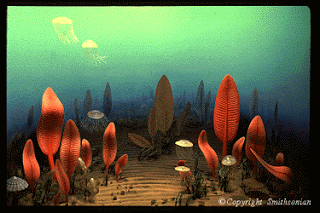 Ediacarans
Ediacarans
People who are skeptical about evolution (generally, bible-belt americans) don't know what the real gaps are in our understanding - they're caught up in the perception of the nonsense of it all. I think the biggest barrier to to a ready acceptance is simply time. We just don't have a real framework for understanding the scales involved.
Evolutionary changes take place over millions of years - yet we're still into a few thousand of recorded history.
There's little trace of civilisation (the neolithic revolution came with the advent of agriculture) at all beyond the last ice age - which is only 10,000-odd years ago.
Homo sapiens only emerged about 200,000 years ago.
Tools from H Sapiens' ancestor, Homo Erectus, date back up to about 2,400,000 years.
The earliest primates (from which the Homo genus emerged) were 60,000,000 years ago.
Dinosaurs lived from 230 million to 65 million years ago - lost to a catastrophic extinction event at the end of the cretaceous period.
The Cambrian explosion started about 540 million years ago. It was a sudden increase in diversification and complexity of organisms, marking the first emergence of multicellular animals, albeit nothing remotely familar to us now.
Any other life form is referred to as precambrian. Many of those life forms were as alien as they were primitive, illustrating a great variety of evolutionary dead ends.
A recent New Scientist magazine had an article on the precambrian Ediacarans, organisms that lived from about 575 million years ago, up to the Cambrian explosion. They resembled animals in some ways and plants in others, and lived on the sea floor, feeding off organic matter. They looked something between ferns and seaweed, but in a wide variety of shapes.
In 2004, it was discovered their composition was Fractal! - made of fronds composed of smaller, identical fronds, which were in turn composed of smaller, identical fronds, and so on. They were all like that, and they dominated the planet for 30 million years.
Yet for three billion years before that, life was restricted to the microbial level. The theory goes that Ediacarans emerged from the aftermath of the last great ice age of the precambrian era. Much of the Earth was frozen, and when the ice melted, it freed up a soup of organic matter, which fed and fostered the Ediacarans (also helped along by high oxygen levels).
Competing theories on these creatures held that they were either an evolutionary dead-end, or the "long fuse" that lit the Cambrian explosion. The article suggested they were both.
Why the Cambrian explosion in the first place? We're still finding out more all the time, but to my mind, it's simply another expression of the mechanism of evolution.
Evolution is a process, not a theory, and it's a long, long story. It's entirely mechanistic, but with such a lot of events, characters, mystery and plot turns that it can keep us eternally fascinated.
No comments:
Post a Comment